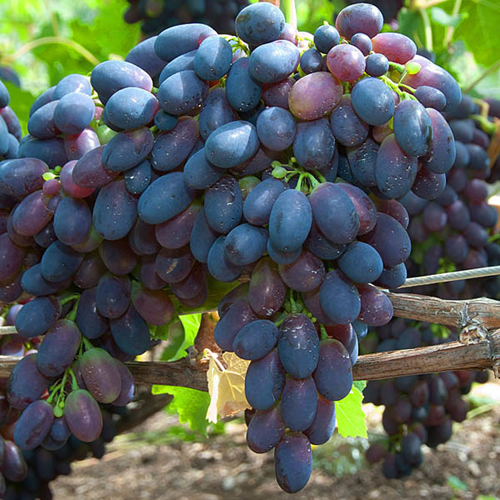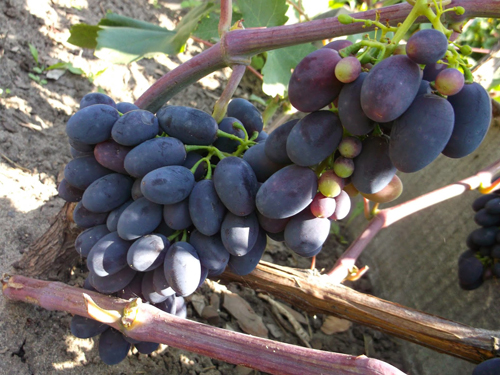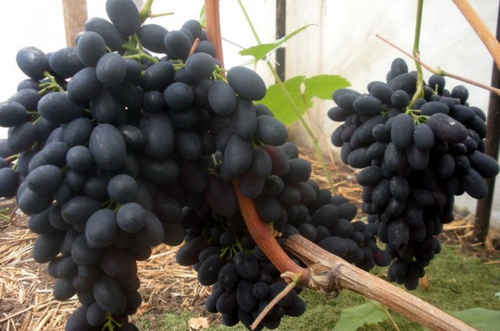Grape variety Codryanka
The table variety Codreanka can confidently be called the pride of the Moldavian Research Institute of Viticulture and Winemaking. Indeed, in addition to wide distribution in its homeland and in the post-Soviet space, this variety, wonderful in almost all respects, has found recognition in Western Europe. So in Italy, which has long been famous for its viticultural traditions and knowledge of good grapes, a patent was acquired for the reproduction and cultivation of Codryanka under the new name Black magic.

In Russia, since 1997, the variety has been included in the state register of selection achievements in the traditional southern viticultural regions - the North Caucasus and Nizhnevolzhsky. However, in many respects, the unique properties of Codryanka caused its popularity among amateur winegrowers, who expanded the geography of its distribution many times over. Among such distinctive qualities, first of all, of course, it is necessary to include its ultra-early ripeness, which, in combination with dark-colored large berries, is a great advantage among competitors. In addition, the variety has a high yield, good marketable fruit, transportability and excellent taste characteristics, provided that a high agricultural background is maintained and all recommended technological operations in the vineyard are observed.
Grapes were bred in 1985 by crossing such famous varieties as Moldova and Marshalsky. It was zoned in Moldova in 1992, after which it began its triumphal march across many countries of the world.

Codryanka bushes are characterized by high vigor. The leaves are medium, rounded, three-lobed, slightly dissected, light green, slightly reticulate-wrinkled above, and have an easily erasable cobweb pubescence below. The upper lateral notches are deep, closed. The lower notches are almost absent. The petiole notch is open, lyre-shaped. The denticles are triangular-sawtooth. The flower is bisexual.
Bunches of grapes are large, conical or cylindro-conical, loose, with an average weight of 400-600 grams, but often grow up to one kilogram. The berries in the bunch are not squeezed by each other and are well ventilated. The comb is strong, of medium length, green, but with a long preservation of the bunches on the bush, it can acquire a yellow-brown tint at the base. The stalks are thin and long, with a firm attachment of the berries. Codryanka berry is large, has a size of 31 × 19 mm and a weight of 6-8 grams or more. The shape of the fruit is oval-oblong with a pointed end. The color is dark purple. The skin is thin, but at the same time strong, covered with a waxy bloom. The pulp is fleshy, juicy. The taste is simple, harmonious. The dense pulp and a small amount of seeds, which are hardly noticeable when eating, determine the high taste and overall tasting assessment of the grapes.

The crop is intended for fresh consumption, but, in addition, it is possible to obtain rich, good quality compotes from it. Early ripening, good adaptability of the crop to long-distance transportation while maintaining its presentation determine the high value of the variety for commercial production. In the south, during the Codreanca harvest season, there are very few offers of dark-colored grapes on the market, so there is no doubt that it will definitely find its buyer.
So, as already noted, the variety belongs to the ultra-early ripening group. It manages to ripen even in the Moscow region, although it still produces the best quality fruits in the southern latitudes rich in sun and warmth. The duration of the growing season from the awakening of the eyes on the vines to the onset of the removable maturity of the bunches is 116-120 days. Due to the rapid decrease in acidity, the berries are quite edible even earlier than this period, however, an incompletely ripe crop will be slightly bland in taste.A similar problem can disappoint winegrowers in regions with an insufficient number of sunny hot days: Codryanka grown in the shade has an inexpressive herbaceous taste, because in a short growing season this plant desperately needs light and heat to form a high-quality sweet rich harvest. The yield of the variety under optimal conditions reaches 120-130 centners per hectare. Ripening of shoots is good. The percentage of fruitful shoots is 72. The number of bunches per developed shoot is 0.8, per fruitful - 1.2. The sugar content of the juice of grapes is 15-17%, the acidity is 5.5-6.5 g / l. After ripening, the bunches can continue to hang on the bush for a long time. At the same time, no loss of consumer qualities is observed.

From an agrotechnical point of view, Kodryanka also looks very dignified, although it has some flaws in agrobiology. Of the positive qualities, it should be noted good resistance to major diseases, phylloxera and very decent frost resistance. In the middle lane, bushes without shelter for the winter, of course, cannot be grown, but in the south, with uncovered formations, the vine can withstand frosts down to -22 ° C. Due to its complex resistance, grapes can be grown with minimal fungicidal treatment. Inherited from one of the parents, the Moldova variety, tolerance to the root phylloxera allows you to grow new bushes from cuttings on your own roots without grafting. However, at the same time, our heroine has good compatibility with many rootstock forms. Protection against pests is standard. With wasps, it will be necessary to fight for the harvest if the berries are on the bush for a long time after ripening.
The main disadvantage of Codryanka is its tendency to peas - the formation of a large number of small berries on bunches. This is due to the fact that grapes are one of the last to bloom and pollination occurs mainly with their own pollen. A similar problem can occur if the weather is damp and cool during flowering. To eliminate this disadvantage, it is necessary to improve the variety by clonal selection and additional pollination. One of these clones is the fairly common Codryanka-218. It repeats the main characteristics of its "sister", but at the same time differs from it in the large size of the bunches and berries, as well as in the darker color of the skin. On the palate, it has a slightly perceptible astringency, which, when fully ripe, is replaced by pure, refined, subtle honey shades. According to some winegrowers, it is less prone to peas than the usual Codryanka.
In addition, the use of the growth stimulant gibberellin, a kind of "youth hormone" for plants, gives good results for improving pollination. It is necessary to process the grapes at the optimum time, which is very important for the effectiveness of the product. The best result is obtained by dipping the inflorescences in the solution, while simple spraying may not be effective. As a result of such processing, it is possible to achieve the formation of large seedless berries.
Codryanka begins to bear fruit early - already in the third year. It does not have any special requirements for the soil. It is very plastic, mastered and adapts to growing in different conditions. The bush management system depends on the climate. Under favorable temperature conditions, the bushes are grown on a bole, while in more northern regions, cover-free formations are required. The feeding area of the bush is chosen within 3.2-3.6 square meters. Load - 45-50 eyes per bush. The length of pruning of fruit arrows of grapes should be 4-6 eyes. The variety is responsive to the thinning of inflorescences, early pinching and embossing of shoots.For better ventilation and lighting of the bunches, it is recommended to lighten them, which will certainly have a positive effect on the quality of the resulting crop.
In general, if you competently approach the cultivation of Codryanka, effectively use its advantages and neutralize the disadvantages, then the aesthetic, gastronomic, and even economic result, in the case of growing grapes for sale, will certainly delight you.









The variety grew for me for 5 - 6 years and turned out to be the biggest disappointment. Its only advantage is that it ripens earlier than anyone among the dark varieties. Almost every year the vine froze, and there was a truly severe winter only once. I have not yet had a variety more sensitive to frost. They managed to get the harvest only twice. I didn't like the taste of the grapes, it was simple and inexpressive. There were few bunches. Many berries are covered with light, so the appearance of the brush is also not very beautiful. As a result, the bush was removed.